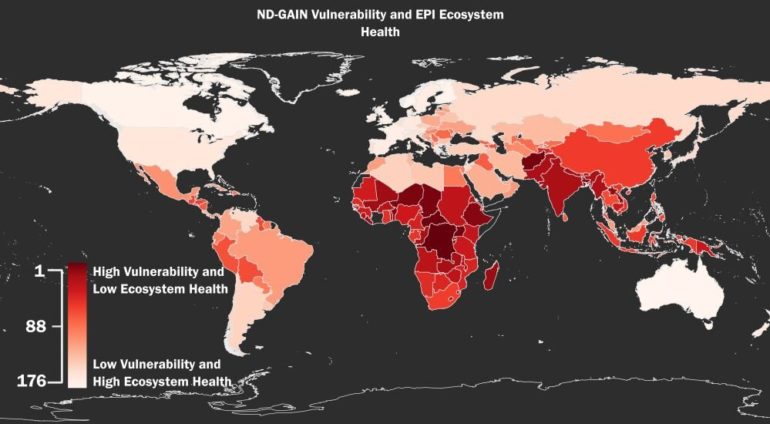A new analysis of global datasets shows low-income countries are significantly more likely to be impacted by both toxic pollution and climate change—and provides a list of at-risk countries most (and least) able to immediately begin direct efforts toward pollution risk reduction, according to a study published July 7, 2021 in the open-access journal PLOS ONE by Richard Marcantonio from the University of Notre Dame, Indiana, U.S., and colleagues.
In this age of the Anthropocene, it’s clear that human activities are destabilizing our planet across multiple systems. Previous research has shown that low-income countries face higher risks than high-income countries from toxic pollution and climate change; however, few studies have explored the relationship between these two risks.
To test the relationship between toxic pollution and climate change, the authors collated and analyzed three frequently used public datasets, ND-GAIN (Notre Dame Global Adaptation Index), EPI (Yale Environmental Performance Index), and GAHP (Global Alliance on Health and Pollution), using data for 176 countries from 2018.
They found a strong (rs = -0.798; 95% CI -0.852, -0.727) and statistically significant (plow-income countries across Africa and Southeast Asia. The authors note that the demographic, ecological, and social factors at work are interconnected and demonstrate broader patterns of inequality, and also emphasize that physical geography, local structural conditions (such as a relatively low capacity for environmental policy and enforcement), and external factors (such as foreign firms taking advantage of reduced environmental regulation) all play a role in exacerbating risks in these countries. Based on their analysis, the authors went on to create a “Target” list of top-ten countries that could provide maximum returns on any investment for risk reduction based on their risk as well as their structural capacity to enact changes (respectively: Singapore, Rwanda, China, India, Solomon Islands, Bhutan, Botswana, Georgia, the Republic of Korea, and Thailand).
The data used in this study do not capture all forms of harm or potential risk from toxic pollution and climate change—only those measured in the initial datasets. Additionally, the authors note that addressing impacts may require a finer intra-country assessment, since risks can vary widely within countries. However, the immediate findings clearly point to a need to jointly address the effects of pollution and climate change globally, while also suggesting an approach for policymakers worldwide.
The authors add: “Vast work has been done to understand the magnitude and distribution of risk from climate change and toxic pollution, separately. We wanted to know if the spatial distribution of these two types of environmental risks are similar and, unfortunately, our results say that in general they are.”
No excess lead exposure in children near Notre Dame: study
More information:
Marcantonio R, Javeline D, Field S, Fuentes A (2021) Global distribution and coincidence of pollution, climate impacts, and health risk in the Anthropocene. PLoS ONE 16(7): e0254060. doi.org/10.1371/journal.pone.0254060
Provided by
Public Library of Science
Citation:
New analysis reveals global distribution of toxic pollution and climate change (2021, July 21)
retrieved 21 July 2021
from https://phys.org/news/2021-07-analysis-reveals-global-toxic-pollution.html
This document is subject to copyright. Apart from any fair dealing for the purpose of private study or research, no
part may be reproduced without the written permission. The content is provided for information purposes only.
